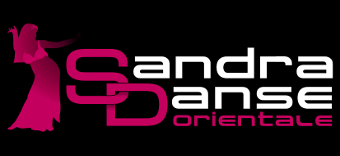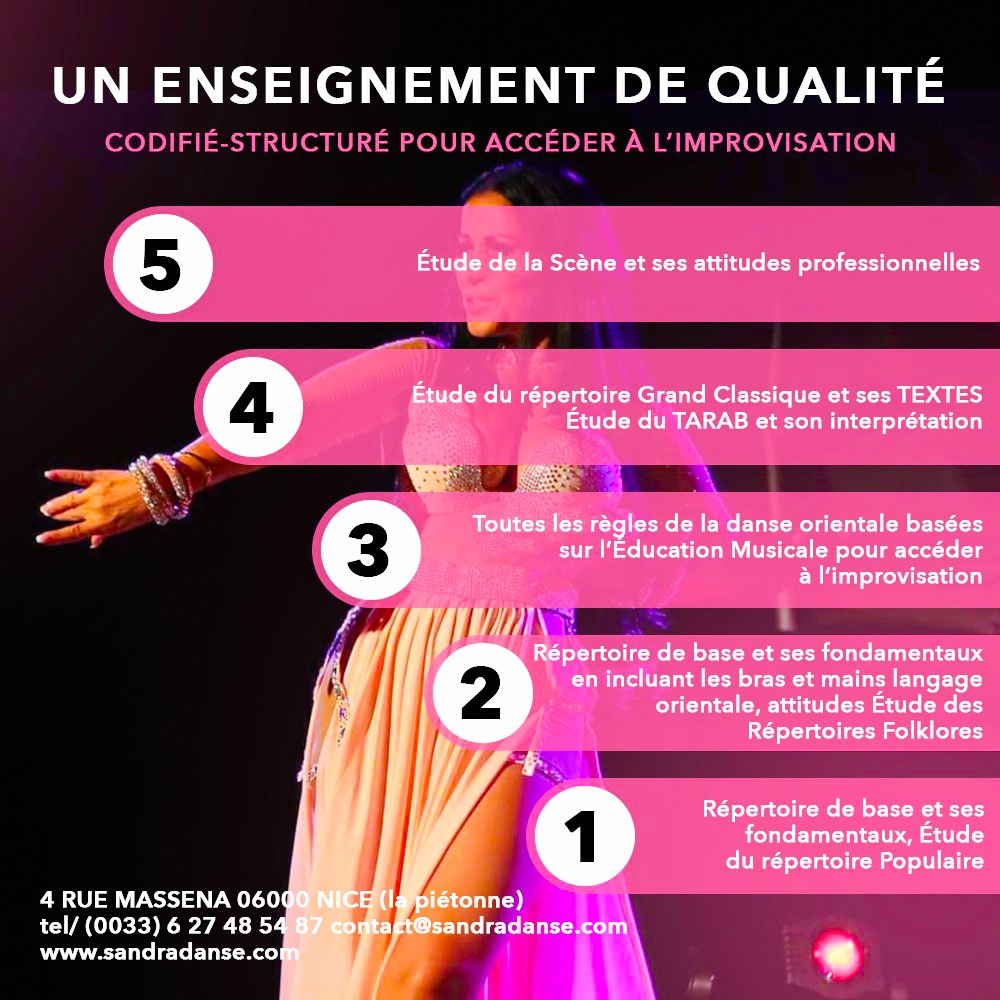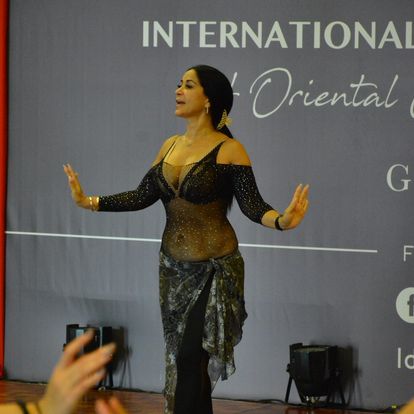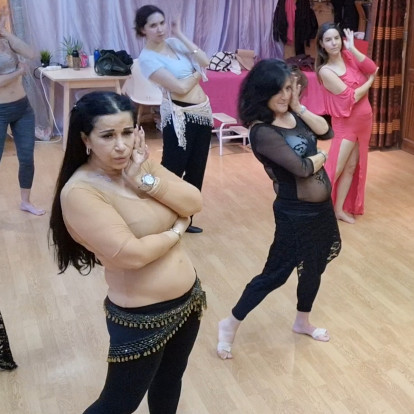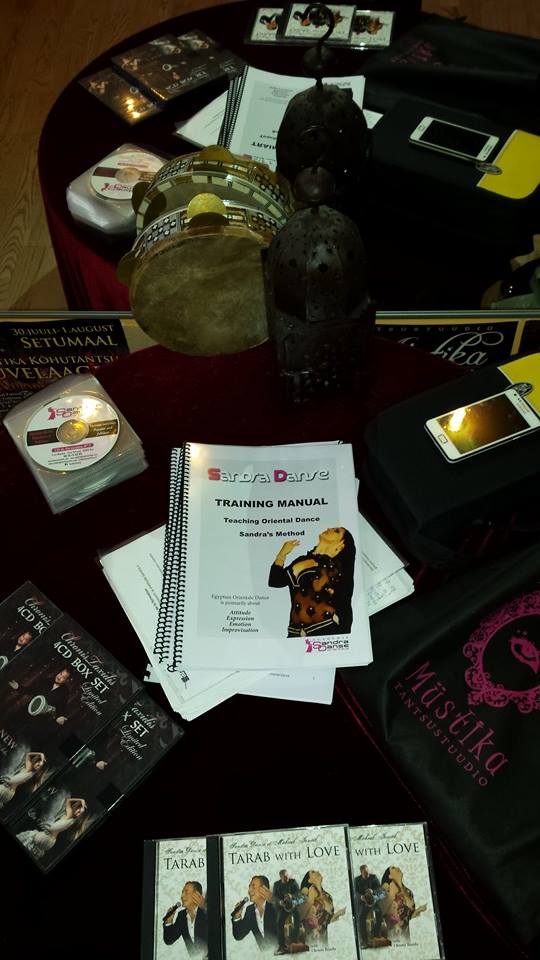Formation Sandra Danse: All Programs
Becoming an Oriental Dance Teacher: A week to get to the basics!
The courses are led by Sandra and her team, according to pedagogical principles that make it a real professional training of quality.
The Sandra Oriental Dance Academy has developed a training in the teaching of dance in several levels. Levels 1, 2, 3,
Levels 1/ Presentation of the Foundations of Oriental Dance to Theoretical and Practical Teaching.
Levels 2/ STEP BY STEP dictionary of codification and structuring to teaching for beginners, intermediate and intermediate-advanced (“student levels 1-2-3”).
Levels 3/ Dictionary of codification and structuring in education for Advanced and Vocational “levels of pupils 4 and 5”.
Each level of training corresponds to an intensive week spread over 6 or 7 days. The training courses are built in modules and it is therefore possible to follow certain modules, for a more à la carte training.
You will find all the details of the training offer by level as well as the formulas on the map by clicking on the level that interests you.
Sandra already trains teachers at the advanced level individually or on international courses.
Oriental Dance is “a body expression and not a body performance”, improvisation is a “presence at the moment and not in the moment” is a “presentation rather than representation”
IT IS NOT THE INTERPRETATION THAT COUNTS BUT WHAT YOU CREATE SPONTANEITY ….
My entire career as a dancer, teacher-choreographer, has been the interest that I have and that I see in teaching improvisation for oriental dance.
First of all, to understand this method, ‘improvisation rests above all on structure.
The Sandra Method has developed tools/ not only these directories, techniques, body language – attitude, but especially these 3 fundamental rules based on “MUSIC EDUCATION”.
The learning of the RULES of IMPROVISATION are necessary to master
His dance through «l’Ecoute Musicale».
Directing both dance and music gives us freedom in our creativity.
«IMPROVISING IS AN ART» one could even consider improvisation as the highest degree of composition as the reflection and performance are inseparably mixed.
The dancer’s attitude towards the present moment is the key to understanding improvisation.
For my part, I consider improvisation through these rules to be essential.
It offers dancers (dancers) total freedom.They dance without restraint, without calculation and often indulge beyond their own consciousness, their thoughts traveling Sant stopping between his body and his sensations.
As an oriental dance teacher, I am primarily trying to convey what I think is most appropriate to understand a reality, particularly in our case “ORIENTAL DANCE” is an artistic reality.
Focus on the study of “rules of improvisation”, an attitude of listening, of presence at the moment, of openness to the possible and unexpected, rather than a gestural form, a staging or a composition procedure.
THE SANDRA METHOD on IMPROVISATION is a method of experimentation and structuring through these RULES… daily practice, technical work, each artist will be able to research, develop, explore, organize, refine his dance, these emotions, his state of mind to put it in execution always and always in IMPROVISATION …
Course Training to be a Teachers of Belly Dance SANDRA METHOD’S
Planning of the training
Level 1: Theoretical Input Practice Exercises Evaluation
DAY 1:
WELCOME OF THE PARTICIPANTS:
Presentation of each participant’s program, method and objectives
Culture: History of dance from the origins to the present day, the great names of music and dance.
Classification of Oriental Dance Styles.
DAY 2:
MUSIC EDUCATION 1:
Presentation of the fundamentals (description of the three branches), study of rhythms, study of instrumental rules.
DAY 3:
MUSIC EDUCATION 2:
Study of orchestral rules, study of vocal rules and large texts.
DAY 4:
TEACHING DANCE KNOWLEDGE:
Learn to teach from a codification of Egyptian oriental dance into 5 repertoires – rules of progression in repertoires and their fusion within dance.
DAY 5:
TEACHING DANCE PEDAGOGY:
Know how to teach oriental dance from a progression in the repertoires: build a course (pedagogy, psychology), a course schedule for the year, a program adapted to each level (beginner, intermediate, advanced).
DAY 6:
SIMULATION DAY:
In the presence of real students on 3 levels (beginners, intermediate, advanced), a simulation course is proposed to put into practice the learning of the formation.
DAY 7:
RUNNING A DANCE SCHOOL:
Presentation of the legal framework of the function of dance teacher, introduction to the management of a company, presentation of the 10 key steps to organize activities (internship, show: the advice of Sandra)
Debriefing: Training debrief, Q&A session and orientation to the modules of the Integral Training in Oriental Dance Teaching.
End of training pot and delivery of certificates.
Level 2: On-the-job training
DAY 1:
WELCOME OF THE PARTICIPANTS:
Presentation of the training programme
Presentation of each participant’s objectives and developments since training 1
TEACHING ORIENTAL DANCE REPERTOIRES
Reminder of the 5 directories of the Sandra method and their progression within the framework of teaching on several levels of courses
repertoire 4 and 5 (familiarize oneself with the professional level of oriental dance and know how to dance them before teaching them)
DAY 2:
TEACHING THE 1ST DIRECTORY
Resumption of the basic steps and their variants, setting up of sequences on variety musics
Training/ simulations in teaching the 1st repertoire
DAY 3:
TEACHING THE 1ST DIRECTORY
Introduction to the tabla
Teaching Baladi and Shaabi
TEACHING THE 2nd DIRECTORY
Recovery of all repertoire of arms and hands, positions on basic steps and their variants
Oriental language (to access directory 4, you must already become familiar with the principle of keywords and gestures of expression)
Training/ simulations for teaching the 2nd repertoire
DAY 5:
TEACHING THE FOLKLORES
Know and teach saïdi
Know and teach fellahi and skandarani
Know and teach khalidji
DAY 6:
TEACHING THE 3rd DIRECTORY
Enumeration of all compilations useful for improvisation
Learn how to compile your own compilations for your students
Training/ simulations for teaching the 3rd repertoire
DAY 7:
TEACHING THE 3rd DIRECTORY
Address instrumental and orchestral rules in his teaching.
Discover and teach the classical oriental repertoire
Mastering and transmitting instrumental and orchestral rules
Training/ simulations for teaching the 3rd repertoire
DEBRIEFING
Training review, Q&A session and orientation to the modules of the Integral Training in Oriental Dance Education.
End of training pot and certification
Level 3: Access the Tarab, know how to dance it, know how to transmit it
The training is organized around the study of ten songs of oriental dance (great classical and variety). Based on a theoretical contribution on the rules of improvisation of the Tarab, the trainees work, according to their level, on how to express themselves in their dance and on how to teach (through explanation and demonstration) the Tarab.
DAY 1:
Morning
Introductory Session:
Resumption of each trainee’s training objectives
Presentation of the training programme
Evaluation of the initial level of trainees on the Tarab:
Each trainee is invited to dance 1min on a piece of Oum Kalsoum to evaluate his knowledge of Tarab.
Afternoon
Introduction to Tarab: what are we talking about?
Tarab in oriental music
Tarab in the oriental dance
DAY 2:
Morning
Understand the Tarab and know how to dance it:
Use of arm and hand language
Tarab improvisation rules for the dancer
Afternoon
Putting into practice:
Enforcement of Music Rules
Teaching Activity: How to Explain and Demonstrate Tarab to Students
DAY 3 AND 4:
Morning
Access the Tarab by studying the texts:
The trainees study the texts of a dozen songs of the great names of oriental music.
Afternoon
Putting into practice:
Students work individually on the interpretation of texts. At the end of the two days, they put together a small collective choreography on a piece of Tarab.
DAY 5:
Morning
From Tarab to Mawel:
Initiation into the main attitudes known as “Mawel” which allows the dancer to make her dance both more professional and more authentic.
Afternoon
Simulation and end of training evaluation:
Each trainee proposes to the other members of the group, over a period of 20 minutes, a small session of explanation/ teaching of the Tarab and putting it into practice.
Debriefing:
Collective evaluation of the quality of training, successes and gaps. Individual evaluation of trainees (identification of points/weaknesses by Sandra).
At the end of the training, all trainees must master the rules of improvisation of the Tarab (be able to explain them and demonstrate them to others) and master the main attitudes of repertoire 5 (Mawel).
